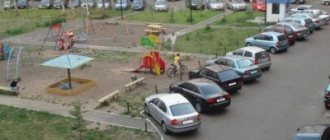What the law says about lighting the local area of an apartment building
The surrounding area is the space around residential buildings (administrative complexes, private and public buildings).
The area adjacent to the house is called the home area. It includes all land plots near the house (both private and multi-apartment), regulated by the right of ownership or use of the site and intended for servicing the house, namely:
- Ground under the building.
- Walkways and sidewalks, playgrounds, lawns and flower beds.
- Areas for recreation and sports.
- Car parking.
- Reasons for economic needs.
Knowing what the territory of the house is and what its boundaries are, residents can protect themselves from illegal buildings inside their yard (kiosks, counters).
Such territories must necessarily have demarcated areas. For such cases, geodesy is used. Geodesy (surveying) is a method of establishing the boundaries of a piece of land using surveying methods. It includes a set of works to determine and secure the boundaries of the area and its territory. An understanding of what land management is will be required when legalizing documents for a land plot.
Such areas must be illuminated at night. Installation and maintenance of lighting devices are carried out by special authorized utility companies. According to the law, lack of lighting near houses creates a danger for adults and children.
Requirements for organizing yard lighting
Such requirements are contained in the Housing Code of the Russian Federation, as well as other legal sources:
- Federal Law No. 131-FZ.
- Decree of the Government of the Russian Federation of August 13, 2006 No. 491.
- Letter of the Ministry of Construction of Russia dated September 18, 2017 No. 33418-ACh/04.
The organization must have documents confirming state registration of commercial activities, as well as a license.
The company must make mandatory transfers to the appropriate budget in order to avoid the imposition of sanctions and cessation of activities for a certain period. A business license number is required for many businesses before they begin operating. Others can get by with just a tax identification number. It depends on the city, the subject of the Russian Federation, where it is formed and operates, as well as on the type of business.
Several factors come into play when determining whether a business requires a license or tax identification number. In many cases, both may be needed. Familiarization with this requirement is just one of many steps an entrepreneur must take when starting a business.
Who is responsible for paying for street lighting?
Date: March 7, 2021 |
Category: Questions and Answers Tags: Street lighting This material was prepared by specialists.
Do you need electrical installation or electrical measurements? Call us! Natalya Alekseevna We live in the village of Mantorovo, Penza region. The head of the settlement, in response to our question about who should pay for the light on the street, said the following: “The lantern is located on the territory of your house, which means that receipts will be sent to you. If you don’t want to pay for the entire street, go door to door and collect money in equal shares.” He did not accept our indignation. Are residents themselves responsible for paying for street lighting? We were sure that payment for the common territory would be the responsibility of the administration of the rural settlement.
Answer Based on Article 14, paragraph 1, subparagraph 19 and Article 16, paragraph 1, subparagraph 25 of the Federal Law of October 6, 2003 No. 131-FZ “On the general principles of organizing local self-government in the Russian Federation,” the organization of street lighting is a matter of local importance. Thus, the costs of maintaining and operating street lighting facilities (payment for electricity spent on street lighting, depreciation of street lighting facilities, remuneration of workers involved in maintaining street lighting networks, etc.) must be reimbursed from the funds allocated for these purposes in the budget of the appropriate level, regardless of whose balance sheet the street lighting facilities are located on.
Federal Law of 06.10.2003 N 131-FZ (as amended on January 9, 2021) “On the general principles of the organization of local self-government in the Russian Federation” Article 14. Issues of local significance of urban and rural settlements (Name as amended by the Federal Law dated May 27, 2014 N 136-FZ.) 1. Issues of local importance of an urban settlement include: (Paragraph as amended by Federal Law dated May 27, 2014 N 136-FZ.) 19) approval of rules for landscaping the territory of the settlement, establishing, among other things, requirements for the maintenance of buildings (including residential buildings), structures and land plots on which they are located, the appearance of the facades and fences of the relevant buildings and structures, a list of landscaping works and the frequency of their implementation; establishing a procedure for the participation of owners of buildings (premises therein) and structures in the improvement of adjacent territories; organization of improvement of the territory of the settlement (including street lighting, landscaping of the territory, installation of signs with street names and house numbers, placement and maintenance of small architectural forms), as well as the use, protection, protection, reproduction of urban forests, forests of specially protected natural areas located within the boundaries settlements; (Clause as amended, put into effect on January 1, 2012 by Federal Law of November 30, 2011 N 361-FZ.)
Article 16. Issues of local importance of the urban district 1. Issues of local importance of the urban district include: 25) approval of rules for the improvement of the territory of the urban district, establishing, among other things, requirements for the maintenance of buildings (including residential buildings), structures and land plots on which they are located , to the appearance of the facades and fences of the relevant buildings and structures, a list of landscaping works and the frequency of their implementation; establishing a procedure for the participation of owners of buildings (premises therein) and structures in the improvement of adjacent territories; organization of improvement of the territory of the urban district (including street lighting, landscaping of the territory, installation of signs with street names and house numbers, placement and maintenance of small architectural forms), as well as the use, protection, protection, reproduction of urban forests, forests of specially protected natural areas located in boundaries of the urban district; (Clause as amended, put into effect on January 1, 2012 by Federal Law of November 30, 2011 N 361-FZ.)
Other and useful information
Other and useful information
Lighting standards
The norms and rules of street lighting are regulated by various regulations and GOST (state standards). These include:
- GOST R 55708-2013.
- GOST R 55707-2013.
- GOST 4677-82.
- GOST 28682-90.
- GOST IEC 60598-2-3-2012.
- GOST IEC 60598-2-5-2012.
- GOST IEC 60598-2-13-2011.
- GOST R 55706-2013.
- SNiP 23-05-95.
- MGSN 2.06-99.
- And others.
In such legal sources, the viewing angle of the light beam is regulated (if the distance between them is greater, more height of the poles will be required), illumination dimensions (the optimal height is taken into account and calculated), brightness (if the required light intensity is greater, then they need to be set lower than the expected level).
Street lighting standards in populated areas vary depending on the objects. The following are standard:
- The tilt angle is at least 80-90 degrees.
- The installation angle is respectively 30 Cd for 80 degrees and 10 Cd for 90 degrees (calculation is made at 1000 lm).
- The brightness is set to 10-50 cd depending on the tilt angle when calculating per 1000 LM.
Entrance lighting
With the onset of darkness, the lights must be turned on in the entrance and stairwells of a residential building. First of all, this is necessary for the safety of residents. Lighting in the entrance of an apartment building must meet the following requirements:
- in public spaces a general lighting system is used;
- if the house has more than 6 floors and more than 50 people live, then the building must be equipped with evacuation lighting;
- evacuation lamps are installed in the main passages and in front of elevators;
- It is allowed to use incandescent lamps, halogen and LED lamps;
- It is recommended to cover the lamp with anti-vandal, impact-resistant glass or metal mesh;
- The light intensity must comply with established standards.
Illumination standards are regulated by special regulatory documents, SNiP and GOST and standardized according to VSN 59-88. Lux values for public areas are presented in the table:
| Room | Illumination standards, Lux |
| Lift shaft | 5 |
| Ventilation chambers, electrical panels | 20 |
| Bicycles and strollers | 20 |
| Stairwells | 20 |
| Lobby | 30 |
| Concierge room | 150 |
Residents have the right to complain to the management company not only that there are no lamps, but also that their light is not intense enough.
Who receives complaints
If residents identify any shortcomings or violations, they can create an individual or collective request to eliminate them. Such complaints can be submitted to the service provider, state and municipal authorities within the established time limits.
Depending on the problem, it is recommended to indicate in the complaint the authorized body whose responsibilities include eliminating the deficiencies.
Sample complaint
The complaint must be written in writing and sent in person or via Russian post or email. There is no legally established form.
The complaint must include the required details (several problems can be identified in one document):
- In the header of the document, indicate the name and address of the location of the utility organization or state or municipal body, as well as the full names of the persons who signed the complaint.
- A descriptive part indicating all the shortcomings with links to legal norms and the word “Please.”
- Signatures of persons with transcripts.
- Date of preparation.
Based on this principle, an application for the installation of lighting poles and other equipment is also drawn up:
- In the “header” of the document, indicate the name and address of the location of the state or municipal body, as well as the full names of the persons who signed the application.
- A descriptive part indicating the installation location.
- Signatures of persons with transcripts.
- Date of preparation.
This is the basic information that residents will need to receive the full service.
Who is responsible for street lighting in towns and villages?
As a rule, the budgets of towns and villages do not always adequately finance street lighting. Installing lights along each road is an expensive task and often shelved. Every year, a plan is drawn up to equip streets with lamps and the local Administration considers it in accordance with the budget. It is mandatory to install lights at road intersections where the risk of an accident is most likely, near administrative and educational buildings.
The district department of Energosbyt is responsible for maintenance, but control over the proper performance of its duties lies with the local municipality. It would be more correct to contact them orally, simply by calling by phone or in writing, filling out the same complaint.
Who maintains street lighting on poles
Street lighting is also maintained by public utilities.
But, payment for it can be made by local authorities (local government). The local administration of a locality is authorized by law to accept applications from citizens for the installation of poles and lanterns for street lighting. Such applications are considered within a procedural time frame of 30 days.
If an application is left unsatisfied, a citizen (or a group of citizens) has every right to file a claim in court. To do this, you must attach all documentation confirming the refusal to fulfill a legal request.
Street lighting how to write an application
But the distribution of budget funds for lighting specific streets is made only by the Administration of Novocherkassk. However, the area I indicated has not been illuminated for a long time. According to clause 1.1 of the Regulations on the Administrative Inspectorate of the Rostov Region, approved by Resolution of the Regional Government dated May 23, 2012 No. 438, the Administrative Inspectorate of the Rostov Region is entrusted with the responsibility to carry out activities to identify administrative offenses in the field of improvement of urban territories and consider cases of administrative offenses within the competence of the inspectorate, established by the Regional Law of October 25, 2002 No. 273-ZS “On Administrative Offences”. In accordance with paragraph.
Who pays for the lighting of the local area of an apartment building?
All electricity bills are paid by residents of the apartment building. The total amount is divided by the number of apartments. In the receipt sent by the company, this service is designated as GDN (general household needs).
Receipts must be received monthly. Their distribution can be carried out in written or electronic form. Authorized persons (usually employees of public or private organizations) have the authority to deliver them by law.
If you change your address or do not receive payment documents, you must immediately contact your service provider. Otherwise, the citizen will need to pay fines and penalties.
Why is house lighting necessary?
Creating high-quality lighting in the local area is an important part of the infrastructure of every district of the city. Illumination near the house performs the following tasks, which become necessary with the arrival of evening and night:
- creates sufficient illumination of the roadway, which is located in the courtyard of the house. Thanks to it, all irregularities and features of the road surface, as well as the surrounding area, are clearly visible even at night;
- ensuring good visibility both for vehicles entering parking spaces and for pedestrians who are walking around the yard at this time;
- allows people and vehicles to navigate well in space, which minimizes the risk of injury or accident;
- increases safety in yards, since, according to statistics, robbers do not attack their victims in well-lit areas.
Note! High-quality lighting of the house and the surrounding area can improve the crime situation in the area.
Night yard lighting
But in order for the night lighting of an apartment building and courtyard to perform its assigned functions, it must be organized in a certain way, necessarily based on established standards.










